|
|
The north of Tenerife
In the north, Tenerife falls straight behind a cliffy slope of the Teide on a wide surface very shalowly into the sea, so that there is a lot od space for housing estates and cities. The north eastern tradewind that is caught on the mountainside in the north east of the island, carries a lot of humidity, so that the whole northern area is very fertile and green. 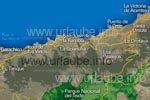
Although the visitors of Tenerife put the north of the island in relation to the touristical centre Puerto de la Cruz, I will start with the little city Garachico, as from the historical point of view it is much more significant than the big city next door. GarachicoUntil beginning of the 18th century, Garachico was the most important city of the north of Tenerife, as Garachico had the biggest and most significant harbour of the whole island. But in the year 1706, some huge lava flows of the Volcán Negro destroyed the beautiful little village with its big harbour. Indeed, the inhabitants of the village of that time could seek shelter in time; but when they went back to the village after the expiration of the volcano, they found it burried under a lava coat. 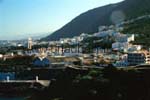
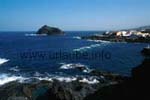
The village inhabitants that returned rebuilt their little village on the cooled lava coat that now went deeper into the sea. But the harbour could not be re-established so that Puerto de la Cruz became the main harbour of the island; While in the course of the centuries, Puerto de la Cruz got more and more developed, Garachico got more and more to an unsignificant village. 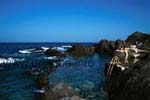
Today, Garachico has approximately 6000 inhabitants and presents itself to the visitors as a cosy village offside of the touristical track. Right at the harbour road there is the Castillo de San Miguel, an old fort from which in former times, the little village of the front side was protected against the enemies coming from the sea. For a little charge, one can see in the interior an exposition of the minerals and shells. Right at the Castillo there is a very attractive sea pool; Each of the pools are really artistically arranged in the landscape of lava rocks. Through the durge, theres is indeed countinuously fresh sea water flushed into each of the pools, but there are hardly waves and the water is lovely clear, so that one can see through the water up to the Ground. The entrance is free; behind it there are some nice cafés and restaurants. Icod de los VinosIf one drives from Garachico on the well arranged road in direction to Puerto de la Cruz, one passes the little city Icod de los Vinos; As the name insinuates, the place is famous for its wines. There are numerus wine taverns in this little place, where one can try and also buy the national wine. 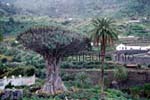

But its real famousness of the little city of 20.000 inhabitants is not its wine but one single tree. Because here, there is the oldest and biggest dragon tree of the world. While it is possible to indicate quite exact datas about its size (15 m height, 4 m cross section dimension of the trunk at the very bottom), the data of its origin are enourmosly diversified: the indications of its age range from 300 to 2000 years. Right beside the famous tree there is also a little nice botanic garden that can be visited for a fee of 3 euros. There, one not only finds some exotic plants, canary birds and lizards but there is also a lovely view to the glorious drasgon tree. In the case of good weather, the straight view up to the top of the Teide is even more impressive. La OrotavaThe city La Orotava with nearly 40.000 inhabitants is affected by the tourism in a form of daily excursions. Anyhow, the Valle de la Orotava was named according to this city, thus the Orotava valley, in which also the cities Puerto de la Cruz and Los Realejos are located. This valley is originated by the mighty landslide 170.000 years ago. 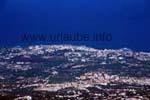
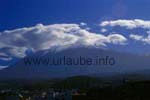
La Orotava was founded in the 16th century by the spaniards, as in this area it was possible to make some good profit in the agriculture, thanks to the climate conditions. Numerous rivers flow from the mountains down to the sea, so that the ground is fertile and useable. It nearly seems to be unbelievable that Puerto de la Cruz was once "only" the harbour of the city Orotava. At the beginning of the 18th century, the city was destroyed by an earthquake, but the town was rapidly rebuilt. Today, one visits the city as a tourist only in the way of a half day excursion. In the old town there is a lively hustle and bustle, as well form the people's but also form the car's side. There are a lot of nice city houses for sightseeing and in the many little street cafés one finds some calmness and relaxation. Puerto de la CruzThe capital of the north of Tenerife is without doubt Puerto de la Cruz. Originally, the place was only the harbour of La Orotava, form which the agricultural goods (mainly sugar cane) and wine were shipped. Today, Puerto de la Cruz is a mighty touristical centre. Huge hotel blocks and tourists blocks tower and and outperform each other. Beauty is really out of question here. 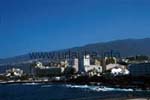
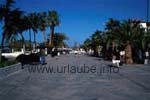
Why is then Puerto de la Cruz so attractive for tourists? Indeed, the climate is during the whole year gentle and balanced, but many times the city is also covered with crowds due to the north east tradewind; Right in the city, there is even not a decent beach. But instead, during the whole night there is party made in Puerto de la Cruz. Already suring the day, one >is informed about what will go on: it is not possible to walk 50 metres alongside the beautiful boardwalk without being orally informed about some parties or restaurants ot at least getting some flyers. 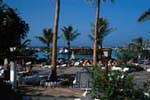
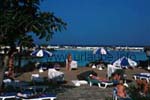
As ugly as the concrete blocks may seem to be, as a compensation, the numerous parks of the city are beautiful. If one walks from the Parque Maritimo Municipal alongside the mian boardwalk up to the Lido San Telmo, one finds a sea pool that outpeforms in size each pool landscape that I have ever seen before. There, thousands of visitors find a place in the pools and on the deck chairs without getting too close to each other. 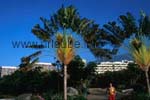
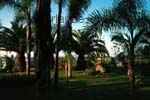
The most beautiful park that I have seen in Puerto de la Cruz is the Playa Jardin, thus a beach garden (literally translated). Behind the huge beach in the west of the city there is a big exotoc garden with some impressive plants of any kind. In this beach and in this garden, one also finds a quietness that can't be found anywhere in Puerto de la Cruz itself. Close to the Playa Jardin there is Loro Parque. It is a huge leisure center. Originally, the park with a size of 12 hectares was an enormous parrot park; but today there are also monkeys, fishes and other animals. Beside animals, there is also a big panorama cinema, numerous restaurants and everything what belongs to a leisure park. The entrance fee is approximately 15 €; a visit is worth without doubt if the weather is bad. But if the weather is fine, there are many more beautiful things to discover in the island. Copyright: Patrick Wagner, www.tourist-guide.biz |
||
